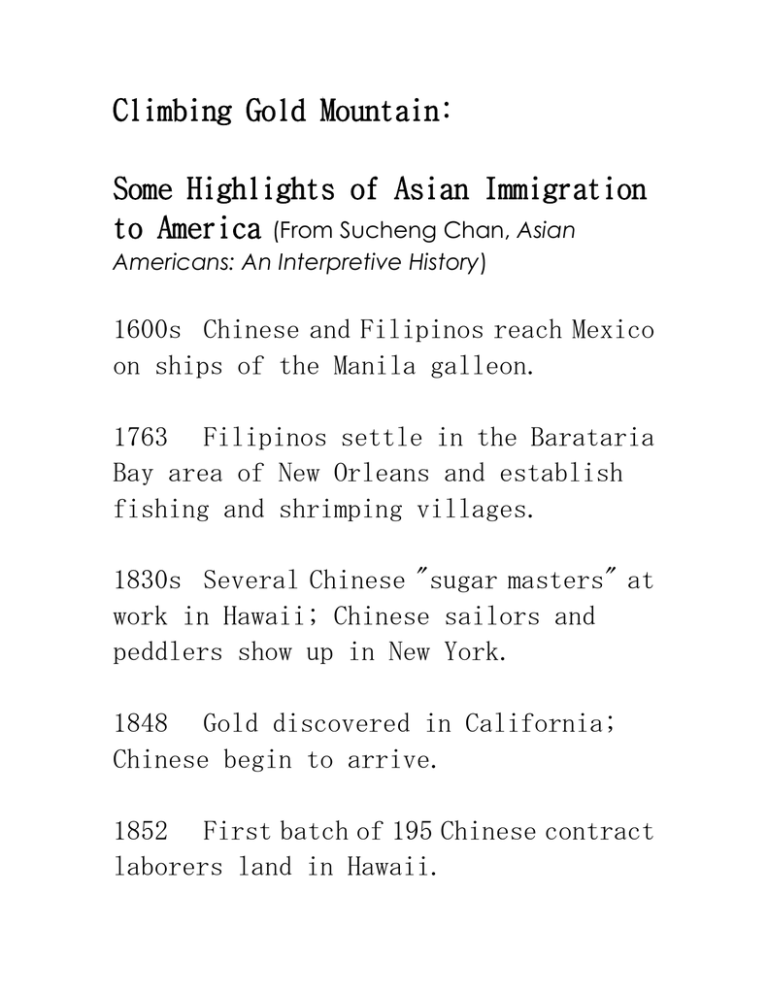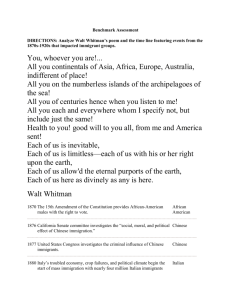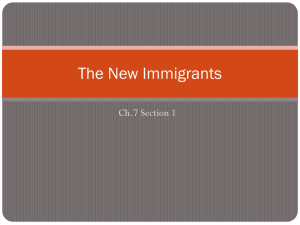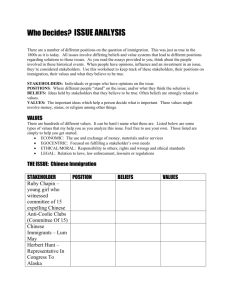Climbing Gold Mountain: Some Highlights of Asian Immigration to America
advertisement

Climbing Gold Mountain: Some Highlights of Asian Immigration to America (From Sucheng Chan, Asian Americans: An Interpretive History) 1600s Chinese and Filipinos reach Mexico on ships of the Manila galleon. 1763 Filipinos settle in the Barataria Bay area of New Orleans and establish fishing and shrimping villages. 1830s Several Chinese "sugar masters" at work in Hawaii; Chinese sailors and peddlers show up in New York. 1848 Gold discovered in California; Chinese begin to arrive. 1852 First batch of 195 Chinese contract laborers land in Hawaii. 1858 California passes a law to bar entry of Chinese and "Mongolians" 1868 U.S. and China sign Burlingame-Seward Treaty recognizing the right of their citizens to emigrate. 1870 California passes a law against the importation of Chinese, Japanese, and "Mongolian" women for prostitution. 1875 Page Law bars entry of Chinese, Japanese, and "Mongolian" prostitutes, felons, and contract laborers. 1882 Chinese Exclusion Law suspends immigration of laborers for ten years; amended in 1884 to require a certificate as the sole permissible evidence for testimony. Chinese laundrymen win case in Yick Wo v. Hopkins, which declares that a law with unequal impact on different groups is discriminatory. 1886 1888 Scott Act renders 20,000 Chinese reentry certificates null and void. 1892 Geary Law renews exclusion of Chiknese laborers for another ten years and requires all Chinese to register; Fong Yue Ting v U.S. upholds constitutionality of Geary Law. 1894 U.S. circuit court in Massachusetts declares in In re Saito that Japanese are ineligible for naturalization. 1898 Wong Kim Ark v. U.S. decides that Chinese born in the United States cannot be stripped of their citizenship. 1903 First batch of Korean workers arrives in Hawaii.; Filipino students (pensionados) arrive in the U.S. for higher education. 1907 Japan and the United States reach "Gentlemen's Agreement" whereby Japan stops issuing passports to laborers desiring to emigrate to the United States. 1917 Immigration Law delineates a "barred zone" from when no immigrants (including Asian Indians) can come. 1922 Takao Ozawa v U.S. declares Japanese ineligible for naturalized citizenship. Cable Act stipulates that any American female citizen who marries an alien ineligible to citizenship would lose their citizenship. 1924 Immigration Act denies entry to virtually all Asians. 1934 Tydings-McDuffie Act spells out procedure for eventual Philippine independence and reduces Filipino immigration to fifty persons a year. 1946 Luce-Celler bill confers the right of naturalization and small immigration quotas to Asian Indians and Filipinos 1965 Immigration Law resulting from the Hart-Cellar Act abolishes "national origins" as a basis for allocating immigration quotas to various countries--Asian countries are finally placed on an equal footing. 1975 More than 130,000 refugees from Vietnam, Kampuchea, and Laos enter the United States as Communist governments come to power in their homelands. 1976 Health Professionals Education Assistance Act reduces influx of foreign doctors, nurses, and pharmacists; President Gerald Ford rescinds Executive Order 9066. 1979 Resumption of diplomatic relations between the People's Republic of China and the United States allows members of long-separated Chinese American families to be reunited. 1980 Refugee Act systematizes the admission of refugees; the government of the Socialist Republic of Vietnam and the United Nations High Commissioner for Refugees set up an Orderly Departure Program to enable Vietnamese to emigrate legally.






